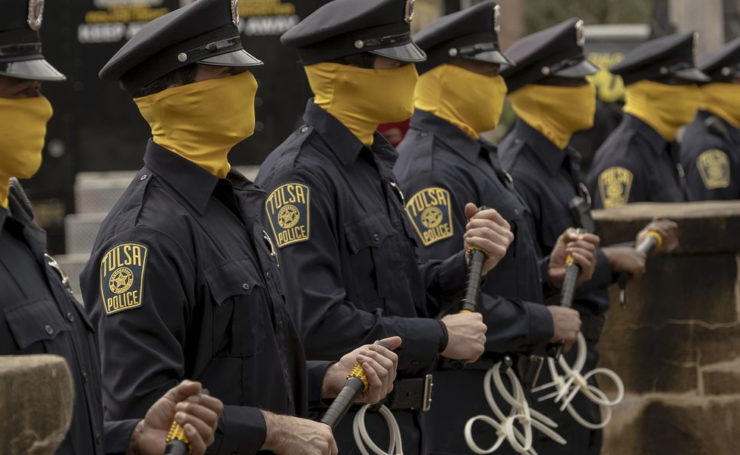As people across the country grow increasingly aware of police brutality, systemic racism, and abuses of power, we’re hearing calls to abolish the police. To be sure, there is some disagreement about what that statement means, ranging from reduced funding and increased oversight to literal abolition. But more and more people are reassessing the need for the kind of modern, militarized police force that has resulted in so much violence and death in communities across the U.S.
For some, it’s hard to imagine a world without a police force. Even if they’re sympathetic to the idea, many have questions: Who will solve crimes? Who will stop criminals? Who will keep us safe?
Those questions require complex answers. People much smarter than me are offering those answers, working hard to provide the first steps to systemic change, but for the moment, I can address the issue of imagination.
While a world without police might seem unimaginable, we actually imagine alternatives to familiar forms of law enforcement all the time, in the form of superheroes. There are some exceptions, but almost every superhero is a private citizen who protects the community by solving and stopping crimes.
There are, of course, some potential objections to the idea of superheroes as alternatives to police. The first is the fact that superheroes are make-believe. Which…I know. My point here isn’t that we should abolish the police and all somehow become superheroes. Please don’t do that. If you get bitten by a radioactive spider, you will get a trip to the hospital, not superpowers.
Rather, my point is that we are quite comfortable thinking about ways to be safe and help the people in our communities without police involvement. I’m pointing out that comfort in the popular imagination as a way to bridge the gap from initial skepticism about abolition to implementation of the practical, realistic steps needed to rethink and change our current system.
Buy the Book


Riot Baby
The other big objection is that superheroes are inherently fascist and, therefore, much worse than our current situation. This objection carries a lot of weight. After all, superheroes are individuals who, thanks to their financial or physical powers, consider themselves exceptional. They take it upon themselves to work above the law and punish those that they consider bad.
Everything from The Incredibles to Watchmen (both the original comic by Alan Moore and Dave Gibbons and the recent HBO series from Damon Lindelof and Nicole Kassell) have explored this issue, but the biggest offender here is Batman. As a comics fan, I understand why the character is so popular and iconic, but Batman is fundamentally a guy who uses his great wealth and influence to beat up the poor and mentally ill, instead of…you know, going to therapy to work through his issues.
But while this fascist bent can be an aspect of superheroes and their stories, it’s far from the only facet, the only arc to be explored. Superhero stories also imagine ways that people can care for and protect one another, and how they can act as allies and advocates for the powerless.
One of the most surprising examples of this type of story occurs in the current Green Lantern limited series Far Sector. No type of character better captures the connection between superheroes and police than a Green Lantern, because they are space cops, acting as interstellar law enforcement. Each member of the Green Lantern Corps receives a power ring from their alien overseers, the Guardians of the Universe. The ring allows them to create anything they can imagine, which they use to capture bad guys and either bring them to local authorities or, in extreme cases, hold them in Science Cells on the planet OA.
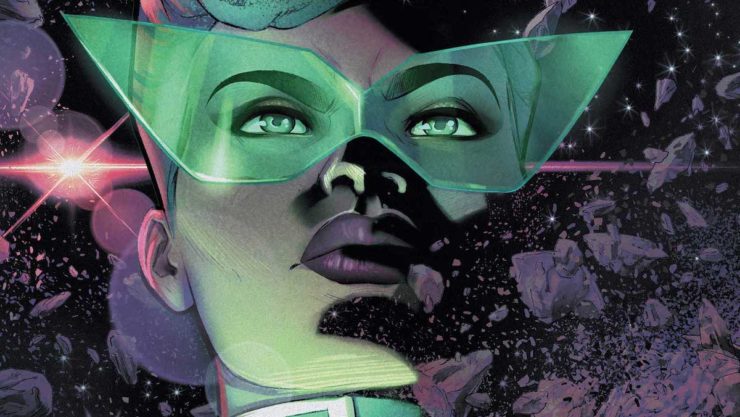
Written by N.K. Jemisin and drawn and colored by Jamal Campbell, Far Sector introduces a new Lantern in Sojourner “Jo” Mullein. A former soldier and member of the NYPD, Mullein wants to make a difference but finds herself frustrated by abuses of power in the military and the police force. After witnessing her partner assault an unarmed Black man, Mullein resigns from the NYPD but is recruited by a Guardian who gives her a special mission. Acting as an adjunct to the Corps, Lantern Mullein has been invited to investigate a murder in the distant mega-metropolis The City Enduring—their first in nearly 500 years.
The leadership of The City Enduring has specifically requested a human Green Lantern because of their expertise in emotions. Citizens in The City have lived without feelings for several centuries, thanks to a biological override called the Emotion Exploit. However, some citizens feel empty without emotions and begin to deactivate the Exploit by using a drug called “Switchoff.” Tensions between those who want their emotions and those who need them suppressed create division and lead to murder in The City.
Jemisin writes Lantern Mullein less like a traditional superhero and more like a film noir detective. In stories like The Big Sleep and The Maltese Falcon, it’s clear that regular people can’t trust cops or crooked government officials to help them. When someone “unimportant” gets hurt, it’s up to outsider gumshoes like Philip Marlowe or Sam Spade to solve the crime—a crime that usually leads back to the corrupt people in power.
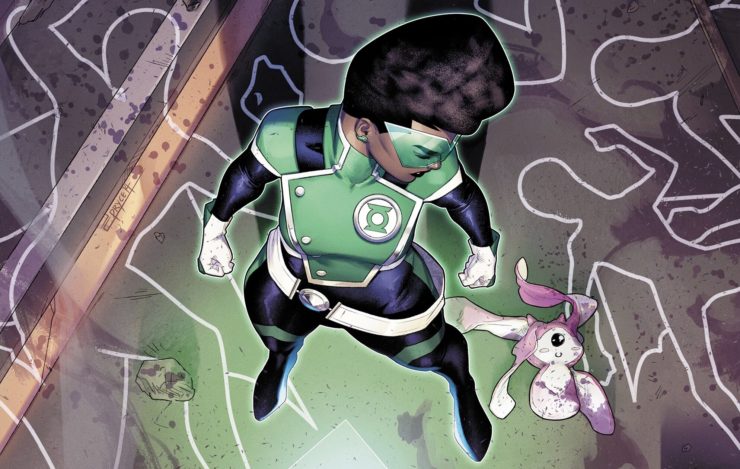
As the only human—and thus the only person familiar with emotions—in The City Enduring, Lantern Mullein very much embodies this archetype. She uses her ring not to punch or terrorize the citizens she encounters, but to move around the city and look for evidence. That evidence often puts her at odds with the leaders who invited her to The City, leaders who think they can control Lantern Mullein in order to protect their secrets.
But make no mistake, Lantern Mullein is a true superhero, as demonstrated in a dynamic scene in Far Sector #3. Called to deal with a protest against the Emotion Exploit, Mullein has to keep those set against change from harming the activists. The police force wants to use lethal weapons to kill the protestors, and have the authorization to do so from The City’s council. But Mullein knows that won’t restore the peace; it will only lead to tragedy and further unrest.
Over Campbell’s powerful images of Lantern Mullein flying toward the crowd in a burst of green energy, Jemisin uses caption blocks to capture Mullein’s internal struggle. Shutting down conflict may bring momentary peace, Mullein thinks, “But it’s not real peace, see. Doesn’t deal with the actual problem, just tries to pretend it doesn’t exist for a while.” Mullein uses her powers to move the conflict toward a real, richer, lasting type of peace: Creating a massive, but transparent, barrier to separate the protestors without hurting anyone, Lantern Mullein stands…and listens. She lets each side explain their worries and fears, and begins a process to let those concerns be heard and acknowledged.
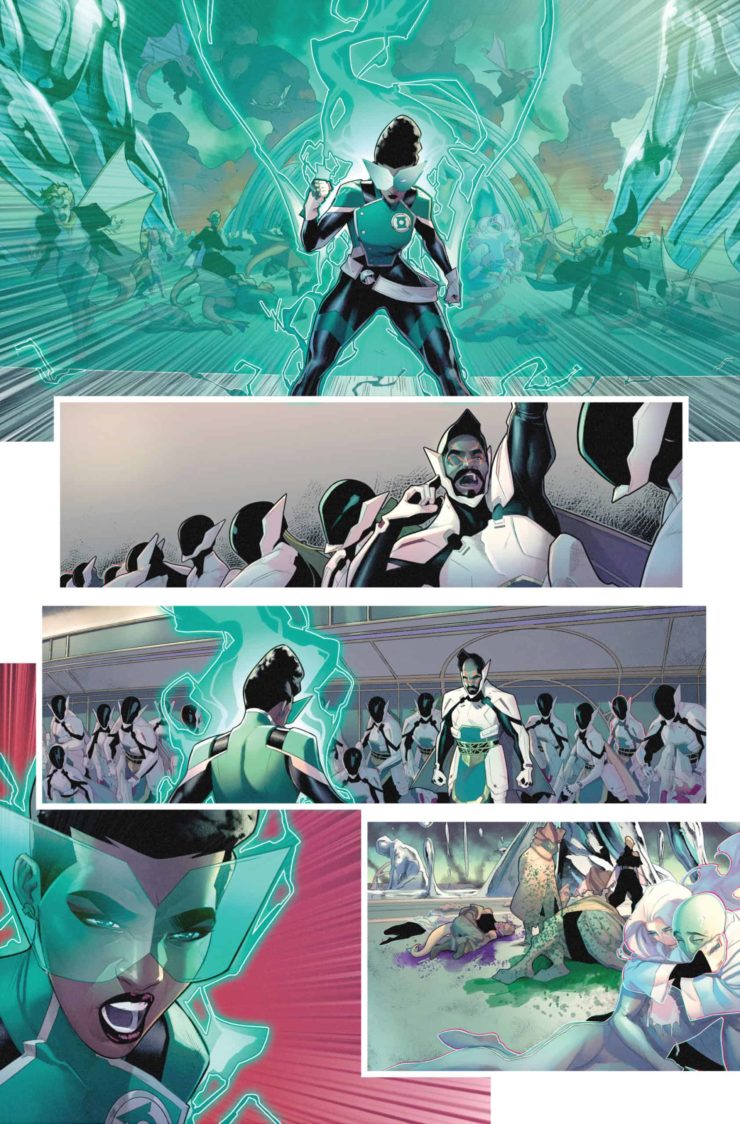
By her own admission, this type of peacekeeping is “slower” and “harder”; it requires “listening, and change.” It would be so much easier for her to simply overpower the protesters and force her own ideas of right and wrong upon them. Instead, Lantern Mullein models one of the most important demands made by advocates of police reform and racial justice: acknowledging the root problems driving inequality, working to give the people what they need and recognizing that everyone—not just the privileged—has the right to live in peace.
While Lantern Mullein is a newer character, still relatively unknown outside of comics fandom, Spider-Man—one of the most popular mainstream superheroes of all time—also embodies alternatives to the police. The story of nerdy young Peter Parker, who gets bitten by a radioactive spider and gains the ability to do whatever a spider can, can sometimes devolve into a base power fantasy. Indeed, writers sometimes ask us to cheer when the once-bullied nerd overpowers the macho Flash Thompson or, uh, almost murders him with Tony Stark’s drones.
But more often than not, Peter is driven by the belief (retroactively attributed to his late Uncle Ben) that “with great power comes great responsibility.” Spider-Man doesn’t see his amazing abilities as giving him permission to do whatever he wants, to allow his might to dictate what’s right. Rather, his powers inspire a sense of duty because they allow him to protect and take care of others, to look out for and help his neighbors in whatever way he can.
Take one of the most famous Spider-Man moments: the train sequence from 2004’s Spider-Man 2 (directed by Sam Raimi). When his battle with Spider-Man (Tobey Maguire) takes him to the top of an elevated train, the villainous Doctor Octopus (Alfred Molina) has a plan: tear out the train’s controls and send it hurtling toward the end of the track. Rather than continue fighting Doc Ock, Spidey races to save the passengers, standing at the front of the train and using his webs to slow it down. In the process, Spidey pushes himself to his physical limits, sacrificing his body and even his secret identity, as his mask flies off.
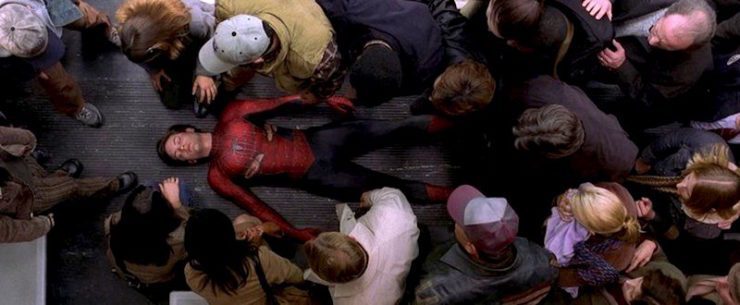
When the train finally stops, the exhausted Spider-Man collapses, nearly falling off the broken tracks until the passengers (including veteran voice actor Phil LaMarr!) reach out and gently pull him back to safety. As Danny Elfman’s inspirational score plays in the background, the passengers slowly carry Spider-Man to the back of the train and tenderly set him down. “It’s alright,” a man reassures him as regains consciousness, and a young boy returns his missing mask, speaking for the rest of the passengers when he promises, “We won’t tell nobody.”
The scene demonstrates Spidey’s relationship to power. He doesn’t regard his special abilities as a means of to making himself look good, or to acquire wealth or power, or even to simply protect himself. He uses his strength in the service of empathy, helping others who are in need, trying to handle the problems they can’t.
Even if the recent MCU movies keep sending him to outer space and all over Europe, Spider-Man remains irrevocably tied to Queens and the city of New York, where he’s a member of the community. He’s profoundly invested in his neighborhood and the lives of the people who live there, not an enforcer seeking to control others through fear and intimidation.
That’s also true of the newest Spider-Man, Miles Morales. In 2018’s excellent Spider-Man: Into the Spider-Verse, Miles’ (Shameik Moore) new superpowers coincide with the arrival of several Spider-Men (and women…and a pig) from other dimensions. At the film’s climax, the various Spideys find a way back to their worlds via a dangerous supercollider created by the Kingpin (Liev Schreiber) and Doctor Octopus (Kathryn Hahn), but one of them must stay behind to make sure that the collider gets destroyed before it consumes the city. Peter Parker (Jake Johnson) volunteers, despite the fact that he will likely die if he stays in Miles’s dimension.
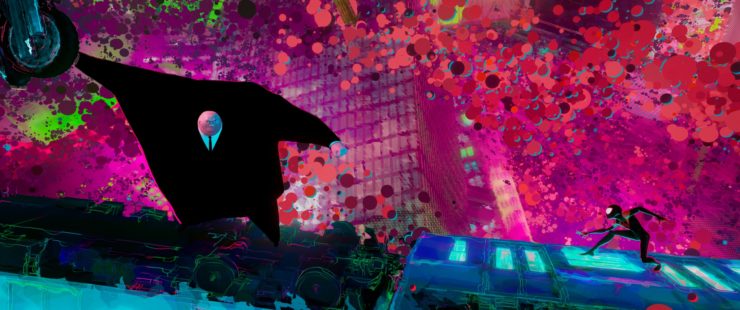
But with a quick bit of sleight of hand, Miles overtakes Peter, sending his mentor home so that he can protect his own world. With his father (Brian Tyree Henry) watching and with the memory of his Uncle Aaron (Mahershala Ali) driving him on, Miles stops the Kingpin from destroying the neighborhood.
For all of its psychedelic visuals and dimension-hopping action, the scene illustrates another key claim driving conversations about police abolition: members of the community should look out for one another. Whether it’s Peter Parker or Miles Morales, no one embodies that virtue better than your friendly neighborhood Spider-Man.
Again, I realize that these are made-up stories. And I realize that reducing police power and setting up alternative systems of public safety is a complex process, fraught with more problems than any fictional story about guys in tights can ever hope to address. My point is this: we need to do better than our current police situation allows, and we know we can do better. We know this because we keep telling ourselves stories about justice and empathy, about listening to communities and addressing inequality, about using strength to help and heal, not intimidate. We dream about and cheer on superheroes who care about peace and safety for all, because we know that’s what we should be striving for. Now it’s time to follow our imaginations into reality. Let’s make it happen.
Joe George’s writing regularly appears at Bloody Disgusting and Think Christian. He collects his work at joewriteswords.com and tweets nonsense from @jageorgeii.










